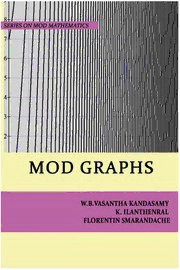
Preview MOD Graphs
W. B. Vasantha Kandasamy Ilanthenral K Florentin Smarandache MOD Graphs Many books can be downloaded from the following Digital Library of Science: http://www.gallup.unm.edu/eBooks-otherformats.htm ISBN-13: 978-1-59973-469-9 EAN: 9781599734699 Printed in the United States of America MOD Graphs W. B. Vasantha Kandasamy Ilanthenral K Florentin Smarandache 2016 This book can be ordered from: EuropaNova ASBL Clos du Parnasse, 3E 1000, Bruxelles Belgium E-mail: [email protected] URL: http://www.europanova.be/ Copyright 2016 by EuropaNova ASBL and the Authors CONTENTS 7 Preface HISTORY OF NEUTROSOPHIC THEORY AND ITS APPLICATIONS 13 ABOUT THE BOOK Chapter One BASIC CONCEPTS 15 Chapter Two MOD GRAPHS 17 Chapter Three MOD NATURAL NEUTROSOPHIC GRAPHS AND THEIR PROPERTIES 91 Chapter Four MOD BIPARTITE GRAPHS 217 FURTHER READING 335 INDEX 343 ABOUT THE AUTHORS 348 5 Peer reviewers: Professor Paul P. Wang, Ph D, Department of Electrical & Computer Engineering, Pratt School of Engineering, Duke University, Durham, NC 27708, USA Dr.S.Osman, Menofia University, Shebin Elkom, Egypt. Said Broumi, University of Hassan II Mohammedia, Hay El Baraka Ben M'sik, Casablanca B. P. 7951, Morocco Florentin Popescu, Facultatea de Mecanica, University of Craiova, Romania. PREFACE History of Neutrosophic Theory and its Applications Zadeh introduced the degree of membership/truth (t) in 1965 and defined the fuzzy set. Atanassov introduced the degree of nonmembership/ falsehood (f) in 1986 and defined the intuitionistic fuzzy set. Smarandache introduced the degree of indeterminacy/ neutrality (i) as independent component in 1995 (published in 1998) and defined the neutrosophic set on three components (t, i, f) = (truth, indeterminacy, falsehood): http://fs.gallup.unm.edu/FlorentinSmarandache.htm Etymology. The words “neutrosophy” and “neutrosophic” were coined/ invented by F. Smarandache in his 1998 book. Neutrosophy: A branch of philosophy, introduced by F. Smarandache in 1980, which studies the origin, nature, and scope of neutralities, as well as their interactions with different ideational spectra. Neutrosophy considers a proposition, theory, event, concept, or entity, "A" in relation to its opposite, "Anti-A" and that which is not A, "Non-A", and that which is neither "A" nor "Anti-A", denoted by "Neut-A". Neutrosophy is the basis of neutrosophic logic, neutrosophic probability, neutrosophic set, and neutrosophic statistics. {From: The Free Online Dictionary of Computing, edited by Denis Howe from England. Neutrosophy is an extension of the Dialectics.} Neutrosophic Logic is a general framework for unification of many existing logics, such as fuzzy logic (especially intuitionistic fuzzy logic), paraconsistent logic, intuitionistic logic, etc. 7 The main idea of NL is to characterize each logical statement in a 3D-Neutrosophic Space, where each dimension of the space represents respectively the truth (T), the falsehood (F), and the indeterminacy (I) of the statement under consideration, where T, I, F are standard or non-standard real subsets of ]-0, 1+[ with not necessarily any connection between them. For software engineering proposals the classical unit interval [0, 1] may be used. T, I, F are independent components, leaving room for incomplete information (when their superior sum < 1), paraconsistent and contradictory information (when the superior sum > 1), or complete information (sum of components = 1). For software engineering proposals the classical unit interval [0, 1] is used. For single valued neutrosophic logic, the sum of the components is: 0 ≤ t+i+f ≤ 3 when all three components are independent; 0 ≤ t+i+f ≤ 2 when two components are dependent, while the third one is independent from them; 0 ≤ t+i+f ≤ 1 when all three components are dependent. When three or two of the components T, I, F are independent, one leaves room for incomplete information (sum < 1), paraconsistent and contradictory information (sum > 1), or complete information (sum = 1). If all three components T, I, F are dependent, then similarly one leaves room for incomplete information (sum < 1), or complete information (sum = 1). In general, the sum of two components x and y that vary in the unitary interval [0, 1] is: 0 ≤ x + y ≤ 2 - d°(x, y), where d°(x, y) is the degree of dependence between x and y, while d°(x, y) is the degree of independence between x and y. In 2013 Smarandache refined the neutrosophic set to n components: (T , T , ...; I , I , ...; F , F , ...); 1 2 1 2 1 2 see http://fs.gallup.unm.edu/n-ValuedNeutrosophicLogic- PiP.pdf . 8 The Most Important Books and Papers in the Development of Neutrosophics 1995-1998 - introduction of neutrosophic set/logic/probability/statistics; generalization of dialectics to neutrosophy; http://fs.gallup.unm.edu/ebook-neutrosophics6.pdf (last edition) 2003 – introduction of neutrosophic numbers (a+bI, where I = indeterminacy) 2003 – introduction of I-neutrosophic algebraic structures 2003 – introduction to neutrosophic cognitive maps http://fs.gallup.unm.edu/NCMs.pdf 2005 - introduction of interval neutrosophic set/logic http://fs.gallup.unm.edu/INSL.pdf 2006 – introduction of degree of dependence and degree of independence between the neutrosophic components T, I, F http://fs.gallup.unm.edu/ebook-neutrosophics6.pdf (p. 92) http://fs.gallup.unm.edu/NSS/DegreeOfDependenceAndIndepe ndence.pdf 2007 – The Neutrosophic Set was extended [Smarandache, 2007] to Neutrosophic Overset (when some neutrosophic component is > 1), since he observed that, for example, an employee working overtime deserves a degree of membership > 1, with respect to an employee that only works regular full- time and whose degree of membership = 1; and to Neutrosophic Underset (when some neutrosophic component is < 0), since, for example, an employee making more damage than benefit to his company deserves a degree of membership < 0, with respect to an employee that produces benefit to the company and has the degree of membership > 0; 9
